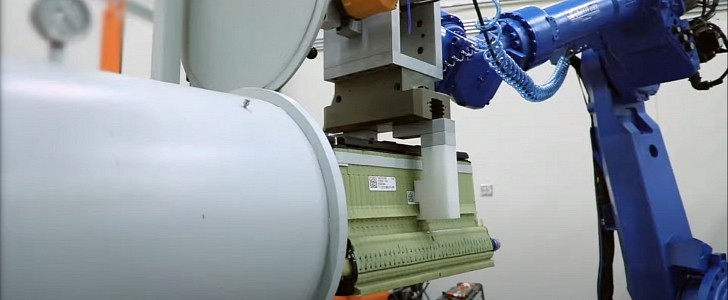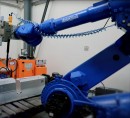The growing market of electric vehicles doesn’t only mean good news for the environment. It also brings some problems with it, as we have to deal with all the EV battery packs once they reach the end of their life cycle. Disassembling and recycling them can be a tricky process and can pose safety issues for the workers. This robotic system can make things easier and faster.
Designed by the researchers at the Oak Ridge National Laboratory (ORNL) / Department of Energy, the automated robotic system can safely and efficiently disassemble the batteries so they can further be analyzed for recycling purposes. This way, human workers are protected from exposing themselves to the toxic chemicals found inside the batteries as well as their high-power levels that can reach 900 volts, which is the case with batteries found in newer EVs.
Both the bolts and the housing are removed with the help of the machine and you can program the automated system to either access the individual battery module for reuse/refurbishment or to take it apart down to the power cell level, to separate the materials.
Aside from posing risks regarding the safety of the workers, manually disassembling the batteries is a time-consuming job. Estimates show that in the time required to disassemble 12 battery stacks by hand, the robotic system can take apart over 100 batteries.
While the automated machine was just used for handling the batteries so far, in the future ORNL plans to expand its list of applications and also use the robotic system for disassembling EV drive trains. This would help in the recovery process of materials such as rare magnets, copper, steel, as well as intact power electronics.
As the EV market is expected to continue its growth over the next 10 to 20 years, Tim McIntyre, principal investigator in ORNL’s Electrification and Energy Infrastructures Division, says we have to view these spent vehicles and batteries as central to the supply chain for manufacturing materials.
Both the bolts and the housing are removed with the help of the machine and you can program the automated system to either access the individual battery module for reuse/refurbishment or to take it apart down to the power cell level, to separate the materials.
Aside from posing risks regarding the safety of the workers, manually disassembling the batteries is a time-consuming job. Estimates show that in the time required to disassemble 12 battery stacks by hand, the robotic system can take apart over 100 batteries.
While the automated machine was just used for handling the batteries so far, in the future ORNL plans to expand its list of applications and also use the robotic system for disassembling EV drive trains. This would help in the recovery process of materials such as rare magnets, copper, steel, as well as intact power electronics.
As the EV market is expected to continue its growth over the next 10 to 20 years, Tim McIntyre, principal investigator in ORNL’s Electrification and Energy Infrastructures Division, says we have to view these spent vehicles and batteries as central to the supply chain for manufacturing materials.







